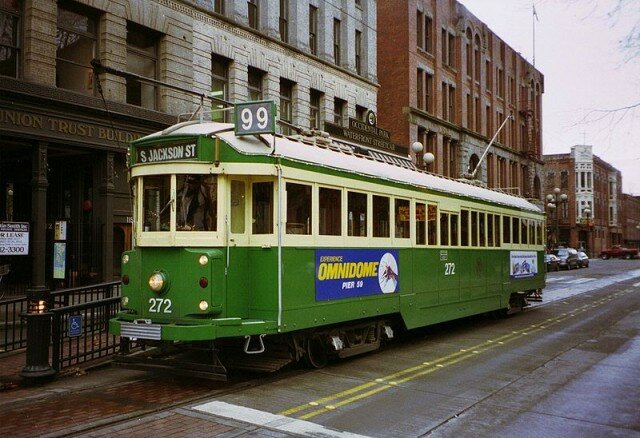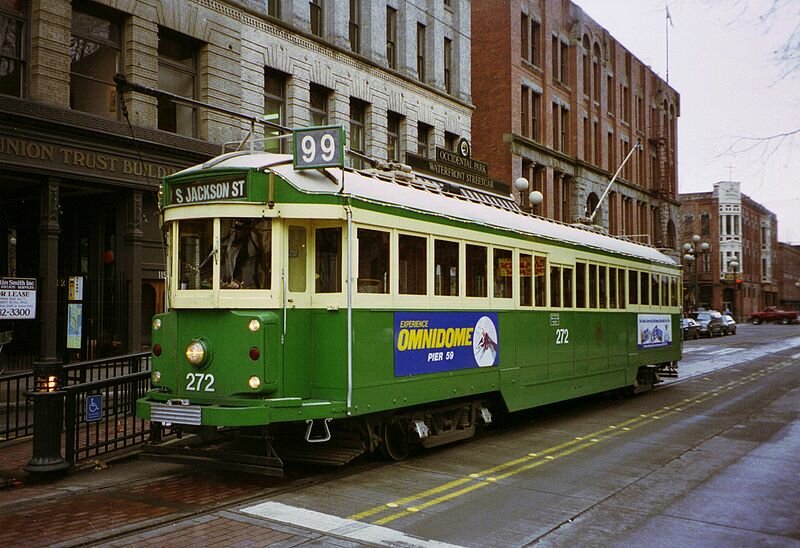
Streetcars are all the rage in Seattle these days; the arguments over the Eastlake line or the Ballard line have mainly to do with timelines. The astounding success of the 1.3-mile Seattle Streetcar line, which carried 700,000 riders in 2011, has illustrated what the prestige of rail can do for transit. But of course Seattle knew that. The Waterfront Streetcar line was a hit with passengers as well — 400,000 rode in 2004 — and the city even paid to have its line extended from 1.6 to a total of two miles in the 1990s.
It was never supposed to go away. The old maintenance barn was in the way of SAM’s Olympic Sculpture Park, so the line was closed down “temporarily” in November 2005. Then the planned new maintenance barn got hung up first by the search for a suitable location, then by the recession. At that point, city leaders wandered away from the issue. In Seattle, everyone can be “in favor of” and “strongly support” something, and it can still languish if no one bothers to lead the charge.
This spring, it was not trumpeted in the news that a section of the track was ripped out as part of the deep-bore tunnel’s construction.
Neither did anyone in city leadership press forward with the results of a 2011 study (pdf), paid for by organizations in the stadium district, that found reactivation of the Waterfront Streetcar line could cost as little as $10 to $13 million. (For comparison, new streetcar lines in Seattle are estimated to cost some $48-to-$50-million per mile.)
As Seattle Transit Blog explained, it wasn’t just that the Waterfront Streetcar line could link up with the First Hill Streetcar line under construction currently. The maintenance barn problem could be solved by having them share space in the First Hill Streetcar barn. They even shared the same track gauge, so that with an upgrade to a common electrical system, the Waterfront Streetcars could tool right into the barn on existing tracks. (The major incompatibility between the historic Waterfront streetcars and new versions is that the Waterfront streetcars are high-boarders, rather than street-level — the whole Waterfront line has raised platforms because of this.)
If the city acted now (this was 2011), the study noted, the Waterfront Streetcar line would be operational by 2013, and help to mitigate tunnel construction impacts on traffic and businesses. It is not clear why this crushingly obvious plan was not executed.
The city and James Corner Field Operations are working together on a redesign of the central waterfront, and they trade off on who, exactly, is insisting that any waterfront streetcar line run not down the waterfront but on First Avenue instead. First Avenue is not where the Bell Street Pier is, where some 30 percent of cruise ship traffic departs. Nor is there likely to be any expensive uphill transportation, and the grade to First Avenue is significant.
The reason for proposing to spend four times as much on a new First Avenue configuration may instead be that the deep-bore tunnel construction needs the real estate the old line uses. So the temporary requirements of a construction project may be dictating long-term transit planning. It is not too late to do the reasonable and cost-effective thing. The historic streetcars are still in excellent condition. And with voters overwhelmingly approving funding for the $290-million Elliott Bay Seawall project, the future of the waterfront is still very much a live topic. To sign a petition and stay updated on progress, visit Save Our Streetcar (Again).
UPDATE: A quote from George Benson, the man who pushed from the creation of the Waterfront Streetcar line, seems apropos to a discussion of why a temporary closure has lasted seven years and counting:
Despite Mayor Uhlman’s public support for the Waterfront Streetcar concept, his planning staff decided that the line would be prohibitively expensive and irrelevant to the larger transit schemes then being developed by Metro Transit, and they set about quietly to sabotage “Benson’s Folly.”
